Ritchie Blackmore's Mk2 sound
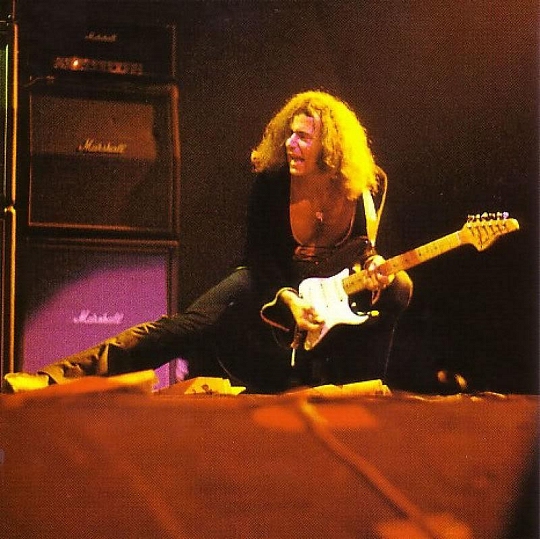
The DP_Mk2 sound of Ritchie Blackmore is dominated by the combination of a treblebooster and a 200 watt Marshall Major amp. The circuit of the Major amps is very unique and has nothing to do with the common 50 and 100 watt models. So the 200 watt Marshall Major is not a louder 100 watt Marshall amp, the Major has a very special tone. During the years, several versions of 200 watt amps had been released, the first edition from 1967 named "Marshall 200" and nicknamed "the pig" (two inputs, three controls for bass, treble and volume) is not important for us here. Only the later versions from 1968-1974 with the typical Marshall cosmetics, four inputs and six controls named "Marshall Major" are important for us, because Blackmore played only this amps. The Marshall Major 200 Watt amp was built in two versions over the years, the first one being from 1968 until late summer/autumn 1969 with the 100ohm "Doorknob" anode resistor at the KT88 power-tubes, please see the schematics. Ritchie stated that during the complete MK1 era only the first series was used without any exception. The follow-up was the well-known production run that was divided into Lead - see schematics, Bass and PA series.
Sporting an ultra-linear power stage, KT88 beam-power tetrodes and a Class-A push/pull driver stage, the Major is close to the typical hi-fi concepts, this is the reason for the tight and focused bass response of this amp. Because of the ultra-linear power stage (aka "screen-grid negative feedback"), the internal resistance of the power stage is lowered notably, or as the hi-fi guys like to call it: the damping factor is raised notably. Because of this, the speaker is driven more precise, especially in the bass frequencies, works more stable and with less tolerances from its nominal parameters, eg. a lower THD factor and a better frequency response. That´s exactly the reason, why the ultra-linear concept is so widely used for high-priced hi-fi units.
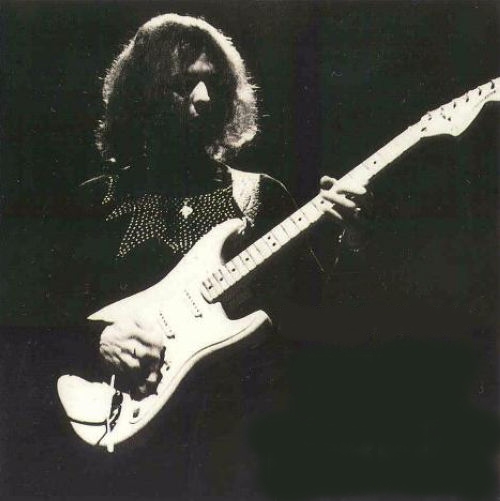
A short remark about the gain factor at the Marshall Major series. Compared with the usual Marshall 100watt series, the Major´s gain was lower, about -6dB lower, therefore it was not possible to overdrive the Major amp with a Strat straight into the amp. Therefore, Ritchie solved this problem … He used a Hornby-Skewes Treble Booster in front of his amp to compensate for the lack of gain and mainly to overdrive the preamp. There is something special to keep in mind: the "Bright" volume control in the "Bright" channel of the Major's preamp not only changed the volume, but, as became common in the so-called Marshall "Plexi" era from 1966 on, also the bass response. The higher the volume was set at the "Bright" volume control and especially from position greater #7, the more bass was additionally reduced. With a high "Bright" volume, the following triode-stage could still be driven hard with a lot of punch. With this high setting, Ritchie liked the sound very much but unfortunately at this setting the Major was very loud. When the "Bright" volume was reduced, however, this dominant crunch effect disappeared. Again, Ritchie quickly found a solution for this issue: the Hornby-Skewes treble booster was simply equipped with an additional volume control at the output of the circuit. This way the Major´s preamp "Bright" volume could remain set quite high while the new volume control of the treble booster controlled the volume to a certain degree. When turning down the "Bright" volume of the Major, the amp quickly lost its tonal magic because of its special circuit design. Later on Ritchie will have his Majors modified. …. To get his amp modified Ritchie went to the Marshall company because he knew Jim Marshall well from his early successless mid 60´s time in the music scene where he spent a lot of time hanging around in Jim Marshall´s music shop. To quote Jim Marshall: "Ritchie more or less lived in my shop". The most important modification in this context was cascading both pre-amp triodes, connecting the unused triode from the Majors “Normal” channel with the stock one, as pre-amp stage with a relatively low gain factor (approx. factor 10 = 20dB instead of the common 35dB of a standard pre-amp tube). Furthermore, an additional 4th tube was installed in each of Ritchie's Majors, about whose actual function only a few people really know anything today, so there is a lot of speculation about it. The following mods over the next years resulted in a VOX-style tone of his amps, giving him his signature Blackmore sound: modified Major amps + HS-Booster + Stratocaster.

During the years, two slightly different versions of the Major lead series (there are also Major models for bass and PA purposes) had been released, the difference was only about one single component, a treble bypass capacitor, soldered between in- and output of the volume pot. In comparison to the 50 and 100 watt Marshall models of this time, this capacitor was small, similar to the ones used on the "Bright Switch" on many Fender amps. Later on, the Major received the same bypass cap like the 100 watt Marshall amps. The reason for this bypass cap was to keep the treble alive, when rolling back the volume. Because of this and depending on the volume, the upper highs were boosted notably. Other than on the Fender, Boogie, Dumble and some other amps, you could not switch off this boost. The Major amps with the treble bypass cap are called "Bright Volume" (BV), this amps did not show up until early/mid 1972 - the amps without the cap are called "Neutral Volume" (NV). After early/mid 1972, only the BV amps were produced. At the end of 1972, Ritchie switched over to this new BV version, its shining, bright tone is easy to identify.
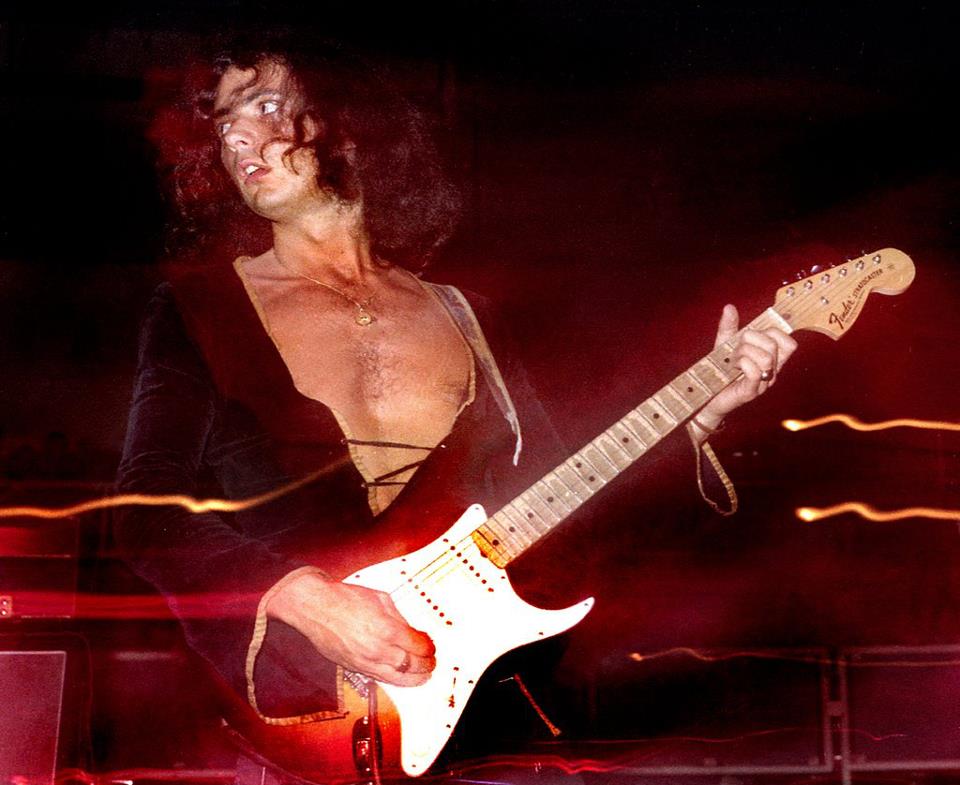
The Hornby-Skewes treblebooster existed is several versions with different gain factors and with at least four different capacitor arrangements and two different transistor setups. Only two of these versions have been used by Blackmore. Until spring 1971, Ritchie used the germanium version of the Hornby-Skewes (HS) version, as well as one of the silicon versions. Ritchie owned three HS booster in 1971, one or two of them was modified in early Mk1 era and received an additional volume control. The silicon version was also used in the studio, eg. on the the Dec. 71 "Machine Head" recordings. For this recordings, he mainly used a VOX AC30.
Why would Ritchie want a volume control on his Hornby-Skewes Booster when his Marshall Major already had such a pot in its preamp? Well, compared to the (not used) „Normal“-channel, the „Bright“-channel volume control on the Major does not operate in a frequency-neutral manner. The more the „Bright“-volume control is turned up, the more the bass is attenuated relative to the treble – the result being that, in simple terms, the bass remains trimmed down at high settings of the „Bright“ volume control. Thus, when adjusting the general loudness via the „Bright“ volume control, Richie regulated the treble-to-bass balance at the same time, as well. It turned out, however, that with the latter being to Ritchie’s liking, the preamp was driven a bit too hard for certain situations. In order to correct the overall gain in the preamp without changing the frequency response, the simple measure was to include a volume pot at the output of the treble booster.
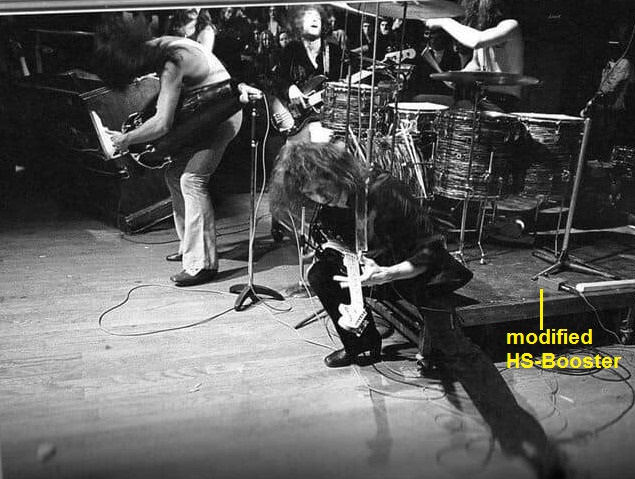
Ritchie then used the services of the late tech Bill Hough who was technical director of the UKs biggest PA rental company I.E.S. (International Entertainers Service Inc.). The company often provided the PA sound system for Emerson, Lake & Palmer and Deep Purple. Therefore the electronic wizard Hough was often in charge of the PA and looked after Keith Emerson's keyboards, because he knew everything about Hammond organs. The two groups often competed in terms of PA power and volume. By the way: Bill was also responsible for all the quadraphonic "Mavis" mixer designs e.g. used at the California Jam 1974 or by the Who. Obviously it was no wonder, Ritchie one time asked Bill for technical help. So Bill built a treblebooster for Ritchie that did not suffer from picking up radio signals and the (bit wah like) mid-rangy and compressed sound of the silicon Hornby Skewes booster. He built his electronics into the enclosure of the modified HS booster model with the additional volume control, by simply taking out all of the original guts. Hough's custom made silicon booster [CM] was also used from spring/summer 1971 until the end of the DP_Mk2 period in summer 1973.
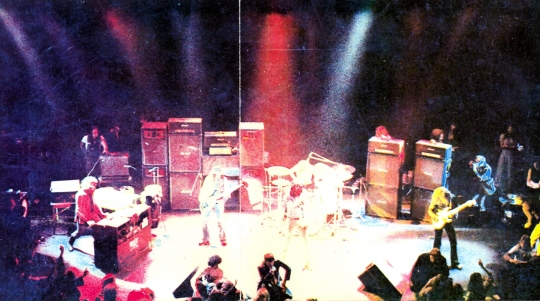
On a lot of live recordings Ritchie used the CM booster, eg. the legendary "Beat Club" session from autumn 1971, the marvelous BBC session (aka "In Concert 1970-72") from spring 1972 - both sporting the fresh and airy guitar sound - but the New York (NY) show from Hofstra University from 1973 as well, this time recorded with a new Major BV version amp. Especially on this recording, it´s easy to hear the additional glassy-brilliant amount of treble as well as the funky, punching bass of the BV Major version.